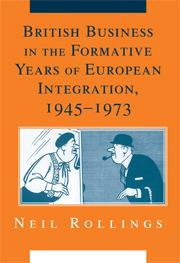Book contents
- Frontmatter
- Contents
- List of Tables and Figure
- Series Editors' Preface
- Acknowledgements
- Abbreviations
- 1 Introduction
- PART I ECONOMIC REALITIES
- PART II THE DEVELOPMENT OF PERCEPTIONS OF EUROPEAN INTEGRATION
- 4 From 1945 to June 1955: The Marshall Plan and the European Coal and Steel Community
- 5 The Establishment of the Common Market and the Free Trade Area Proposals, 1955–1958
- 6 Creating EFTA, Applying to the EC, and de Gaulle's Veto, 1958–1963
- 7 After de Gaulle's First Veto, the Second Application, and the Second Veto, 1963–1968
- 8 The End Game: From the Hague Summit to British Accession, 1969–1973
- PART III EUROPEAN INTEGRATION AS MORE THAN TARIFFS
- Conclusion
- Index
5 - The Establishment of the Common Market and the Free Trade Area Proposals, 1955–1958
from PART II - THE DEVELOPMENT OF PERCEPTIONS OF EUROPEAN INTEGRATION
Published online by Cambridge University Press: 02 December 2009
- Frontmatter
- Contents
- List of Tables and Figure
- Series Editors' Preface
- Acknowledgements
- Abbreviations
- 1 Introduction
- PART I ECONOMIC REALITIES
- PART II THE DEVELOPMENT OF PERCEPTIONS OF EUROPEAN INTEGRATION
- 4 From 1945 to June 1955: The Marshall Plan and the European Coal and Steel Community
- 5 The Establishment of the Common Market and the Free Trade Area Proposals, 1955–1958
- 6 Creating EFTA, Applying to the EC, and de Gaulle's Veto, 1958–1963
- 7 After de Gaulle's First Veto, the Second Application, and the Second Veto, 1963–1968
- 8 The End Game: From the Hague Summit to British Accession, 1969–1973
- PART III EUROPEAN INTEGRATION AS MORE THAN TARIFFS
- Conclusion
- Index
Summary
Few individuals at the time realized the significance of the talks at Messina in June 1955 at which the governments of the Six “recognised that the establishment of a European market, free from all duties and all quantitative restrictions, is the objective of their action in the field of economic policy.” What now with hindsight is often seen as a clear road of development from Messina to the signing of the Treaty of Rome in March 1957 and the establishment of the European Community itself in January 1958 was a most uncertain process. The possibility of Britain joining the EC was quickly ruled out by the British government as it would introduce discrimination against the Commonwealth countries and there was a “parting of the ways.” Just as some historians point to the Schuman Plan episode so others pinpoint Britain's reaction to the EC proposals as the crucial period when Britain “missed the boat.” Even if there was no boat to miss, as Moravcsik and others have argued, it was nevertheless clear from an early date that if the proposals were successful then there would be serious consequences for Britain as a non-member. Politically, Britain would be marginalized as US attention would shift to the Six and, economically, exclusion from a common market containing Germany would not only hand over the markets of the member states but also increase the competitive position of German exporters in third markets, including the Commonwealth.
- Type
- Chapter
- Information
- Publisher: Cambridge University PressPrint publication year: 2007



